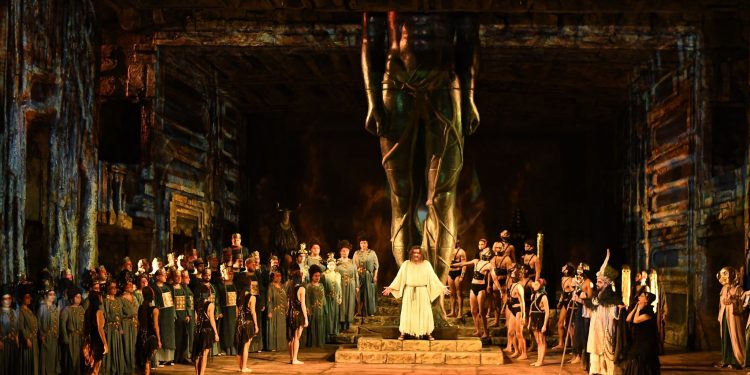The premiere of the popular opera Samson et Dalila by Camille Saint-Saëns was a great success on the stage of the Tbilisi Opera and Ballet Theatre. All tickets were sold out and the performance received a 15-minute standing ovation.
This beautiful production of the Monte-Carlo Opera House was directed by the famous French director Jean-Louis Grinda. One of the most famous Italian artists, Agostino Arrivabene, created the luxurious set of Samson et Dalila, full of the atmosphere of a mysterious temple, the colourful and precious costumes; the striking lighting and lighting effects of Laurent Castaingt and the passionate choreography of Eugénie Andrin transported the audience to a surreal fairy tale of the East.
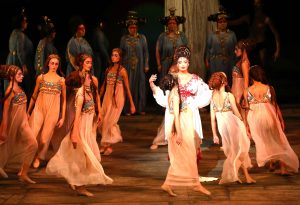
Samson et Dalila featured soloists from the Tbilisi Opera, guest singers, choir, orchestra and ballet company. Maestro Zaza Azmaiparashvili conducted the performance: “The opera was last performed at the Tbilisi Opera Theater in 1944, and since then, 80 years have passed. This new production by the Monte-Carlo Opera House is incredibly beautiful, and the music is fantastic. I am delighted to experience such genius music. We have talented singers from both local and international backgrounds. Our intensive work paid off, as the premiere was a great success.”
George Oniani – tenor
“During my internship at La Scala, I heard Samson et Dalila for the first time. I immediately longed for this beautiful opera to be performed in Georgia and heard by our listeners. Samson et Dalila is a masterpiece. I would like to express my gratitude to the management of the Tbilisi Opera Theater for bringing the production of Monte-Carlo to the Georgian public. Although foreign productions are frequently staged at the Tbilisi Opera House, this one was particularly special. I appreciate this system greatly because it provides an opportunity for many people in Georgia to experience beautiful performances in Monte-Carlo, Paris, or Milan, which they may not have been able to do otherwise.
I am delighted to perform in front of my Georgian audience in Tbilisi. The role of Samson is my debut, and I am pleased that the premiere was a great success.”
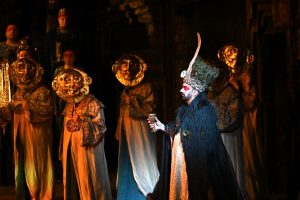
Irina Aleksidze, mezzo-soprano
“I sang the dream role of all mezzo-sopranos after many years. We worked very hard and I think the premiere was a success, as evidenced by the audience’s reaction. Our beloved theatre deserves many more successful premieres.“
Mamuka Lomidze, baritone
“We are all happy to be part of this production. Orchestra, singers, and dancers, worked hard to make Samson et Dalila a production that any great theatre in the world would be proud to stage. Everyone put a lot of hard work into this performance. Congratulations on the successful premiere of Samson et Dalila!”
Irina Sherazadishvili – mezzo soprano
“I am one of the performers of the role of Dalila. It is a longed-for role for all mezzo-sopranos, beautiful, difficult and very interesting both to play and to sing. I can’t imagine a singer for whom any role in Samson et Dalila would not be a dream come true. The music is beautiful and the performance is indescribable. It is a magical production that I highly recommend everyone to see, as it promises an unforgettable experience.”
The next performances of “Samson and Dalila” will be held on February 23, 24, 25 and March 1, 2, 3.
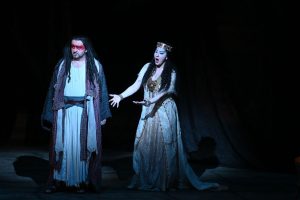
Samson et Dalila was performed on the stage of the Tbilisi Opera and Ballet Theatre for the first time in 1894, exactly 130 years ago. Finally, Samson et Dalila was performed in Tbilisi Opera Theater 80 years ago (1944).
Camille Saint-Saëns wrote 13 operas, but only one has remained in the repertoire of the world’s opera houses. Samson et Dalila is based on the Biblical tale from the Old Testament, with a libretto by Ferdinand Lemaire. It premiered in Weimar on December 2, 1877, and was finally staged at the Paris Opéra on November 23, 1892. Today, Samson et Dalila is one of the most popular operas and is frequently performed in modern opera houses. The role of Dalila is widely regarded as one of the most significant mezzo-soprano opera roles. In 1905, the asteroid was named Dalila after the main character of the opera.
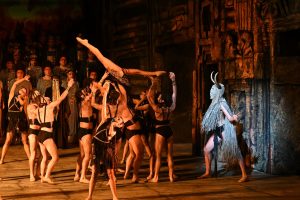
Photographer: Khatia Jijeishvili
Translated by Mariam Mtivlishvili

